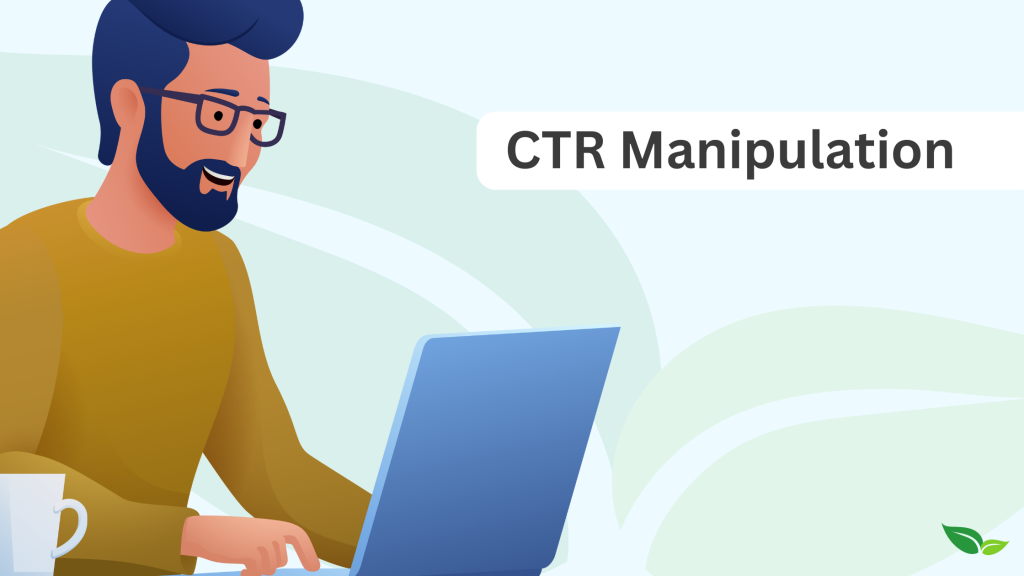Opening the Power of GMB CTR Manipulation for Neighborhood Businesses
Wiki Article
Elevate Your Organic Browse Rankings With CTR Manipulation
The partnership between click-through price (CTR) and organic search rankings is significantly significant in today's electronic landscape - CTR Manipulation Service. By purposefully manipulating CTR with maximized title tags and compelling meta summaries, organizations can enhance their exposure and bring in more users. Nevertheless, this strategy must be performed with accuracy and moral considerations to prevent possible challenges. As we check out the strategies and effects of CTR control, it comes to be important to comprehend not simply the "just how," yet additionally the "why" behind these strategies and their long lasting impact on reputation and growth.Recognizing CTR and Its Value
Comprehending Click-Through Rate (CTR) is vital for any individual wanting to improve their organic search rankings. CTR is the statistics that determines the portion of users who click an internet search engine result contrasted to the overall number of customers that checked out that result. A greater CTR shows that a web page is appropriate and appealing to individuals, which can lead to boosted exposure in online search engine results pages (SERPs)
To profit from CTR, it is crucial to continuously assess and optimize your web content techniques. Strategies such as A/B testing for headings and meta descriptions, in addition to understanding customer behavior, can substantially impact your CTR. Eventually, boosting CTR is a tactical strategy to driving organic website traffic and improving general search presence.
How Internet Search Engine Use CTR
Browse engines utilize Click-Through Rate (CTR) as a considerable variable in evaluating the significance and top quality of search results page. CTR is the ratio of customers that click on a search results page to the complete variety of users that check out the search results page page. A higher CTR suggests that customers locate a particular link engaging and pertinent, signaling to online search engine that the web content is important and worth advertising.Internet search engine continually analyze CTR data to fine-tune their algorithms and improve individual experience. When a specific result constantly brings in clicks, it might be compensated with greater positions, as this actions recommends that the web content properly fulfills customer intent. Alternatively, reduced CTR for an outcome can show an absence of importance, motivating internet search engine to decrease its position.
Furthermore, CTR can vary based on elements such as the sort of content displayed, the placement of the web link, and the nature of the inquiry. Comprehending these dynamics allows search engines to customize outcomes better, improving the possibility that users will certainly locate what they are looking for. Eventually, CTR serves as a crucial statistics that notifies online search engine about customer choices, directing them in delivering one of the most essential results.
Techniques for Reliable CTR Manipulation
Frequently using particular techniques can dramatically improve Click-Through Rates (CTR) for natural search results. One effective method is to optimize title tags and meta summaries. Crafting compelling, clear, and succinct titles that integrate primary search phrases can draw in user interest, while persuasive meta summaries can provide a concise summary of the material, enticing clicks.An additional technique entails utilizing abundant read here snippets, which improve search listings with added visual components such as ratings, photos, or item availability. These functions can identify your listing from competitors, motivating increased interaction.
Additionally, leveraging emotional triggers in your web content can motivate individuals to click. Wording that evokes exclusivity, necessity, or inquisitiveness frequently leads to greater CTRs. As an example, titles that position appealing inquiries or offer services to typical troubles can be particularly effective.
Lastly, consider A/B testing various headlines and summaries to determine which mixes produce the highest possible CTR. This data-driven strategy permits continuous refinement of your methods, inevitably boosting your natural search efficiency. By applying these strategies, you can develop an extra enticing and interesting visibility in search results page, consequently improving your general CTR.
Gauging Your CTR Influence
Reviewing the effect of your CTR control efforts is critical for maximizing organic search efficiency. To successfully determine this impact, start by using analytics tools that track natural search web traffic and user involvement metrics. Google Search Console is a valuable source, offering understandings into click-through prices for particular keywords and web pages, enabling you to recognize which techniques generate the very best outcomes.It's useful content necessary to establish a standard CTR before carrying out any adjustment techniques. This permits you to compare efficiency over time and examine the effectiveness of your initiatives. Monitoring modifications in natural traffic, bounce prices, and conversion prices along with CTR information will certainly provide a detailed understanding of user habits arising from your strategies.
A/B testing can additionally be advantageous; by developing variants of meta titles and summaries, you can measure which combinations cause greater CTRs. Documenting these metrics gradually will certainly facilitate trend evaluation, permitting you to refine your technique consistently. Ultimately, a methodical analysis of CTR influence will empower you to make data-driven decisions, making sure that your natural search positions are regularly elevated and lined up with your general electronic advertising and marketing purposes.
Ethical Considerations in CTR Techniques
When carrying out CTR control approaches, it is important to think about the honest ramifications of such methods. While improving click-through rates is a legit goal for enhancing organic search rankings, the techniques employed should align with ethical standards. Misleading customers via deceitful methods, such as clickbait titles that do not supply on their assurances, can deteriorate depend on and damages brand credibility.Furthermore, participating in techniques that unnaturally inflate CTR, such as using crawlers or incentivizing clicks, questions regarding the integrity of the information existing to search engines. Internet search engine prioritize genuine customer interaction, and controling CTR can result in fines, causing decreased visibility and credibility.
Openness and honesty ought to go to the forefront of any type of CTR technique. Online marketers must intend to offer worth with relevant and high quality web content that satisfies customer expectations. An ethical technique not only cultivates a positive partnership with the audience yet likewise adds to lasting long-term development in organic search performance. Inevitably, balancing reliable CTR techniques with moral considerations is essential for preserving both brand stability and customer rely on a significantly competitive electronic landscape.
Conclusion
In final thought, properly manipulating click-through rates (CTR) acts as a crucial technique for improving natural search positions. By maximizing pop over here title tags and meta descriptions, employing rich bits, and interesting customers emotionally, sites can substantially boost their presence in search results page. Furthermore, ongoing measurement and A/B testing are necessary to improve these approaches. However, maintaining ethical standards guarantees transparency and user trust, fostering long-term development and credibility in the affordable electronic landscape.CTR is the statistics that determines the percentage of customers who click on a search engine result contrasted to the overall number of users that saw that outcome. A higher CTR shows that a web page is attractive and pertinent to customers, which can lead to boosted exposure in search engine results pages (SERPs)

Report this wiki page